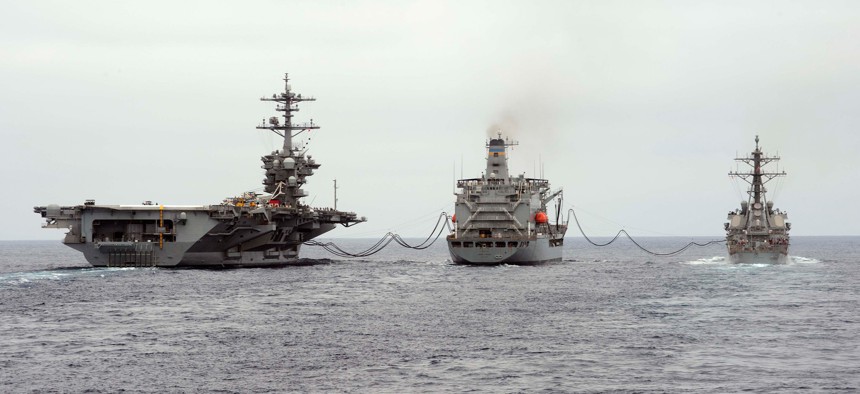
The fleet replenishment oiler USNS Henry J. Kaiser (T-AO-187) refuels the aircraft carrier USS Theodore Roosevelt (CVN 71) and the guided-missile destroyer USS Higgins (DDG 76) during a replenishment-at-sea. Mass Communications Specialist Seaman Chanel L. Turner
The Navy Needs More Money, Its Top Admiral Bluntly Argues
The sea service is pushing for a fleet of 355 ships in the next decade, and that’s not counting unmanned vessels.
The U.S. Navy needs more money for warships — perhaps tens of billions of dollars more over the next decade — if it is to keep pace with China and Russia, its top admiral said.
“We need more money,” Chief of Naval Operations Adm. Michael Gilday said bluntly Tuesday at a Surface Navy Association conference in Arlington, Virginia. “There’s broad agreement across the government that our Navy needs to grow...We need to pursue unmanned technologies and we need to solve tough technology and policy issues associated with unmanned instead of running away from them.”
The admiral spoke less than a month before the White House is to send Congress a 2021 defense budget that is capped at $740 billion — up just $2 billion after three years of substantial growth.
The Navy has been wanting to build a fleet of 355 ships by 2030, up from the 293 it has today. In the coming week, Navy leaders plan to unveil a new force structure assessment detailing the types of ships needed to fulfill its missions.
The admiral said that the 355 will not include unmanned vessels. Insted, the Navy will give a separate recommendation of the number of unmanned ships it needs.
“We haven’t made a decision yet that those [unmanned ships] are going to be included as battle force numbers because they’re conceptual,” Gilday siad.
There’s been a long-running debate about whether unmanned ships and submarines should count toward the 355-ship fleet, particularly as the unmanned vessels grow in size and the types of weapons they could carry.
Gilday said his highest acquisition priority is the Columbia-class submarine, the future bearer of the sea-based leg of the nuclear triad. The class, which currently consumes 20 to 25 percent of the Navy’s shipbuilding budgets, and its share will grow to more than 30 percent by the mid-2020s, he said.







